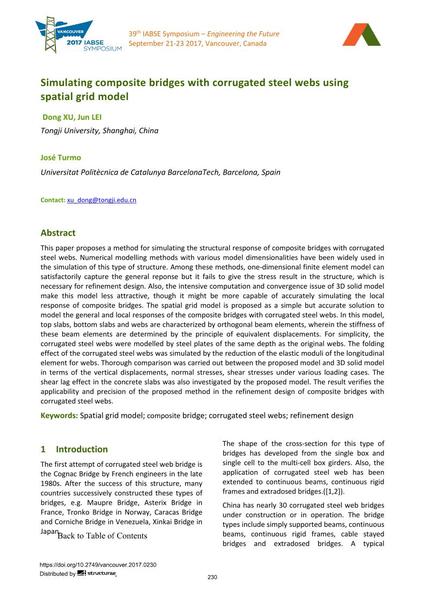Simulating composite bridges with corrugated steel webs using spatial grid model

|
|
|||||||||||
Bibliografische Angaben
| Autor(en): |
Dong Xu
(Tongji University, Shanghai, China)
Jun Lei (Tongji University, Shanghai, China) José Turmo |
||||
|---|---|---|---|---|---|
| Medium: | Tagungsbeitrag | ||||
| Sprache(n): | Englisch | ||||
| Tagung: | IABSE Symposium: Engineering the Future, Vancouver, Canada, 21-23 September 2017 | ||||
| Veröffentlicht in: | IABSE Symposium Vancouver 2017 | ||||
|
|||||
| Seite(n): | 230-237 | ||||
| Anzahl der Seiten (im PDF): | 8 | ||||
| Jahr: | 2017 | ||||
| DOI: | 10.2749/vancouver.2017.0230 | ||||
| Abstrakt: |
This paper proposes a method for simulating the structural response of composite bridges with corrugated steel webs. Numerical modelling methods with various model dimensionalities have been widely used in the simulation of this type of structure. Among these methods, one-dimensional finite element model can satisfactorily capture the general reponse but it fails to give the stress result in the structure, which is necessary for refinement design. Also, the intensive computation and convergence issue of 3D solid model make this model less attractive, though it might be more capable of accurately simulating the local response of composite bridges. The spatial grid model is proposed as a simple but accurate solution to model the general and local responses of the composite bridges with corrugated steel webs. In this model, top slabs, bottom slabs and webs are characterized by orthogonal beam elements, wherein the stiffness of these beam elements are determined by the principle of equivalent displacements. For simplicity, the corrugated steel webs were modelled by steel plates of the same depth as the original webs. The folding effect of the corrugated steel webs was simulated by the reduction of the elastic moduli of the longitudinal element for webs. Thorough comparison was carried out between the proposed model and 3D solid model in terms of the vertical displacements, normal stresses, shear stresses under various loading cases. The shear lag effect in the concrete slabs was also investigated by the proposed model. The result verifies the applicability and precision of the proposed method in the refinement design of composite bridges with corrugated steel webs. |
||||
| Stichwörter: |
Verbundbrücke
|
||||
